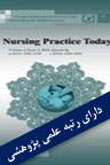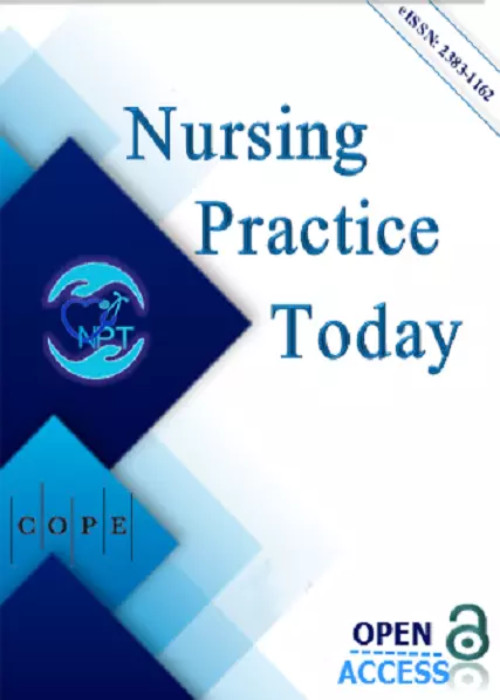فهرست مطالب

Nursing Practice Today
Volume:3 Issue: 1, Winter 2016
- تاریخ انتشار: 1394/12/29
- تعداد عناوین: 6
-
-
Pages 5-10Background and AimPain is a major problem after burn injury. Therapeutic practices do not provide suffi-cient pain relief for patients with burn. Therefore, non-pharmacological interventions such as muscle relaxa-tion and mental imagery can be effective in reducing pain. This study aimed to compare the effects of mus-cle relaxation and mental imagery techniques on pain intensity in patients with second-degree burn.
Methods & Materials: This was a clinical trial study using convenience-sampling method of 135 patients with burn assigned into two groups of experiment, and control group. Pain intensity was measured in the control group on the first and second day after burn injury before and after dressing besides routine practices without any interventions. When the patients in control group were dis-charged, the patients in the men wards 1 and 2 were trained in Bensons muscle relaxation technique and the mental imagery technique, respectively, and patients pain intensity was measured. Then, the mean scores of pain intensity were compared between three groups.ResultsThere was no significant difference between three groups in the mean scores of pain intensi-ty before and after dressing on the first day of burn injury and before dressing on the second day of burn injury (P > 0.05). A significant difference was observed in the mean score of pain intensity after dressing on the second day of burn (PConclusionBoth techniques reduced burn patients pain, and mental imagery had more reducing effect on pain intensity.Keywords: muscle relaxation, mental imagery, pain intensity, second degree burn -
Pages 11-18Background and AimNursing practice is influenced by nurse's precived professional values. A small number of studies have been focused to measure professional values in nursing, whereas most of them focused on measuring values of nursing students. This study aimed to explore how nurses prioritize professional values.
Methods & Materials: In this cross-sectional study, the professional values of nurses who were working at hospitals affiliated to Tehran University of Medical Sciences, Tehran, Iran, were investi-gated. A simple random sampling method was used and 127 nurses randomly selected to participate in this study. A two-part questionnaire was used to collect the data. The first part included demographic variables and the second part included the Nursing Professional Values Scale-Revised (NPVS-R).ResultsThe mean scores of the NPVS-R items on the five point Likert-type scales ranged from 2.89 to 4.32. The most five important professional values statements identified by participants were maintain patient's confidentiality, maintain competency in area of practice, seek additional education to update knowledge and skills, act as a patient advocator, protect patients; moral andlegal rights, re-spectively. The least important identified statement was participating in peer review.ConclusionFindings of this study indicated that nurses are aware about importance of professional values and have been focused to clinical-related elements such as ethical values. Further investiga-tions are needed to evaluate how they actualize these values in practice.Keywords: nurse, professional value, perspective -
Pages 19-25Background and AimComparison of existing curriculums together helps to identify strengths and weaknesses of the program and provide to improve healthy competition. This study aimed to compare geriatric nursing curriculum in Iran and Ireland.
Methods & Materials: This study was carried out in 2015 using Beredy model. Research community was geriatric nursing curriculums in Iran and Ireland. Comparative elements were the mission and objectives, duration and course titles, student admission, working opportunity for graduates, and tui-tion in four steps of description, interpretation, proximity and comparison.ResultsIn Iran, the main focus of program was on clinic, teaching, and research; and employment opportunities were too general. In addition, student admission was centralized and normative and tuition was free. In Ireland, job opportunities were more objective and proportionate to the objectives of the program; admission was done via a decentralized model and students should have selection criteria. In addition, tuition was not free.ConclusionGeriatric nursing curriculum in Iran should be revised to define objective working op-portunities for graduates activities in community, to change methods for admitting student appropriate to their interests and academic and professional backgrounds, and to design educational program for tutor and researcher training.Keywords: nursing curriculum, geriatric nursing, comparative study, Iran, Ireland -
Pages 26-30Background and AimArteriovenous fistula (AVF) is one of the inevitable elements in the take care of patients on hemodialysis. Pain of AVF puncture is a real problem for patients. The purpose of this study was to assess the effect of inhalation of lavender aromatherapy on pain intensity of arteriove-nous fistula puncture in patients on heamodialysis.
Methods & Materials: In this before and after quasi-experimental clinical trial study, 40 patients on heamodialysis were selected using convenience sampling method. Pain intensity measured after needle insertion in AVF in two stages including without any intervention and after using lavender aromatherapy in the three consecutive heamodialysis sessions of each stage. Visual analogue scale was used to evaluate and determine pain. Repeated ANOVA test was used compare the pain before and after interventions.ResultsThe pain scores in two stages of without any intervention and inhalation of lavender aroma-therapy in the three consecutive heamodialysis sessions of each stage were 5.36 ± 2.08, 5.69 ± 2.29, 5.58 ± 2.15 and 4.00 ± 2.48, 3.05 ± 1.94, and 2.97 ± 2.27, respectively. There was significant differ-ences between the pain scores in first time before and first time after (P = 0.003) and first time before and second and third time after (P 0.001) and second and third time before and first, second and third time after inhalation of lavender aromatherapy (P 0.001).ConclusionThe results of study showed inhalation of lavender aromatherapy is effective to decrease pain of AVF puncture in patients on hemodialysis. Therefore, lavender aromatherapy could be a suit-able alternative complementary medicine for the pain of AVF puncture.Keywords: pain intensity, heamodialysis, arteriovenous fistula, lavender aromatherapy -
Pages 31-39Background and AimClinical education is performed within a complex social context in clinical set-tings. Success of the nursing programs depends on appropriate clinical experiences. The aim of this study was to explore clinical learning experiences of Iranian student nurses.
Methods & Materials: Twelve bachelor's degree student nurses were chosen from two large nursing schools in an urban area of Iran. Private face-to-face semi-structured interviews were conducted to collect the data. Data were analyzed using a content analysis approach.ResultsThree main categories emerged during data analysis: "clinical poverty", "clinical distress", and "professional pride". The categories and their subcategories were interrelated and sequential in terms of their occurrence. It was found that students start learning in a non-conducive and non-supportive clinical environment. They experienced different sorts of distress during the clinical placement. However, during the last year of their studies, they gradually reached a sense of control and satisfaction with their learning.ConclusionSince a major part of the learning process of students occurs in clinical environments, proper management of clinical education is of high importance. To foster appropriate clinical teaching and learning, cooperation between the clinical settings and nursing schools is needed to provide a welcoming clinical climate, which values and respects student nurses.Keywords: student nurse, learning experience, clinical placement, qualitative research, Iran


